
On Wednesday the 21st of October, I published the results of our latest study on Google’s Rich Answers. In that study, I showed how Google’s use of these types of results in the SERPs has increased over the past year. However, in today’s post, I am going to emphasize a completely different angle, and I am going to show you an entirely new way to do SEO.
The key to this new approach is understanding how Google is using “Rich Answers” and how to create content that has a chance of earning a Rich Answer result for your site. You can leverage this to jump above the regular search results.
What are Rich Answers, you ask? Let me start by showing you an example. This is at the top of the results after asking Google, “When was Barack Obama born?”:

In the smaller red rectangle on the left, you see that Google answers the question directly, telling you that he was born on August 4, 1961. In the larger red rectangle on the left you see that his age is also calculated for you, as well as information on the birth dates of other famous people. In the red rectangle on the right, you see a lot of other information on Barack Obama that Google thinks might be of interest to searchers who ask about his birth date.
This is an example of a result where Google provides the answer directly. However, you can also see Google providing results where the answers are extracted from third party websites. Consider this response to the query, “How to make an upside down pineapple cake”:
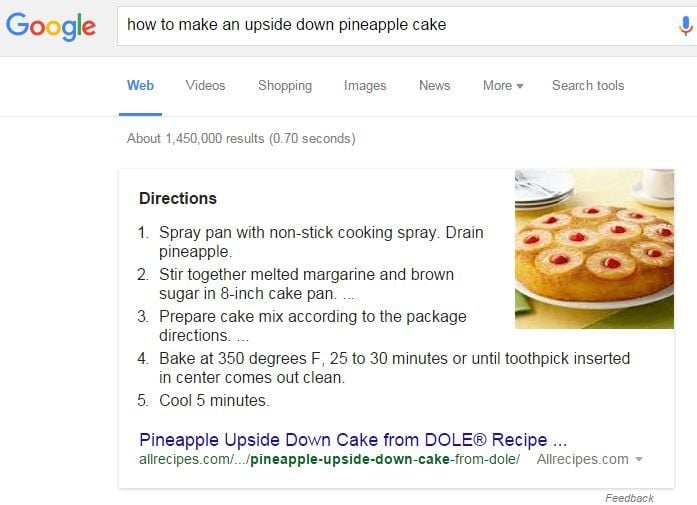
Notice how the answer to this question is obtained by Google from AllRecipes.com. Google calls these types of results “Featured Snippets.” Google includes a link to the site. You can also spot some ellipses in the answer, indicating that the complete answer isn’t quite there, and that the user will have to click through to the site to get the rest of the answer. That’s good for AllRecipes.com.
It turns out that there are three different major categories that Google uses for Rich Answers. These include:
- Featured Snippets: These are results extracted by Google from third-party websites and shown at the top of the web search results.
- Answers provided by Google: Often public domain info, but sometimes from licensed data. These are also shown at the top of the web search results.
- Basic Snippets: These are often shown within the regular web search results. Implementation of schema can facilitate the process of getting these types of enhancements to your search listings.
Rich Answers is the sum of all these things, but the optimization opportunity for you lies with Featured Snippets. The display format used can also vary greatly. Some include images, such as the example shown above, and others don’t. Some include additional data in the right sidebar, as the one above did, and others don’t. Some other types of formats used by Google include:
- Charts
- Tables
- Sliders
- Maps
- Forms
For further reference, here is an interesting example of a chart in response to the query, “What is the population of Russia?”:

How Often Does Google Display Rich Answers in Search?
To figure this out, we took a look at more than 1.4 million queries to see how many of these returned a Rich Answer. 500,000 of these queries were in a “How to” format, such as “How to reset an iPhone.” We obtained this list of queries by extracting them from Google Autocomplete and Bing Suggest. The remaining 900K+ queries were made up of queries that we manually put together. These questions covered a wide variety of topics, such as famous buildings, famous people, books, movies, historical events, sports, and much more. Putting this list of queries together involved hundreds of hours of labor.
Here is the high level summary of the results for all 1.4 million queries:

One key aspect of the questions asked is that they were all designed to maximize the potential that Google might be able to provide a Rich Answer. Therefore, please note that a completely random set of search queries would likely get a much lower overall percentage of Rich Answer queries. You can read more details on the types of rich answers we found in The Definitive Guide to Google’s Rich Answers.
What Makes Featured Snippets a New Type of Optimization Opportunity?
Great question! Let’s start with reviewing how traditional SEO ranking signals work. You can see some of the basics in the Moz Ranking Factors Study. The top ranking factors are shown here:
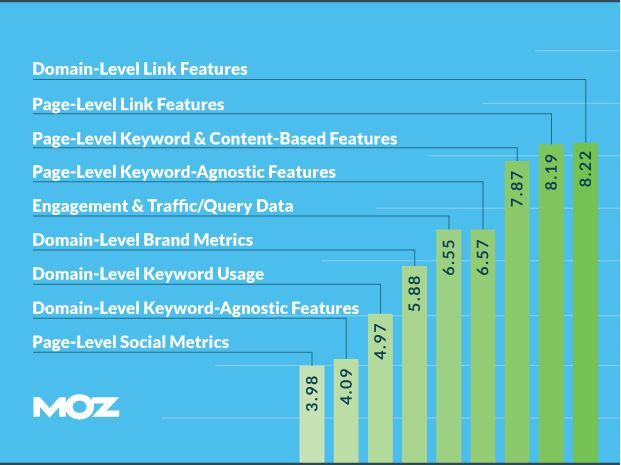
Notice that the top two factors identified are based on links. Links help search engines measure your site’s authority. The combination of relevance- and link-based authority signals have been the core ranking factors since Google’s emergence in 1998.
In recent years, user engagement and content quality have become important ranking factors as well, but, as the Moz data suggests, links remain the king of the hill. More recently, Google has also started using artificial intelligence to help make ranking decisions as well, with a new algorithm they call RankBrain.
What makes Featured Snippets a unique optimization opportunity is that obtaining one for your site doesn’t appear to be dependent on site authority. You can obtain a Featured Snippet for your site without having a high degree of authority, or without being the number one result in the regular SERPs.
Let me illustrate, first by showing you the data on the Moz Domain Authorities for the sites used by Google for Featured Snippets:
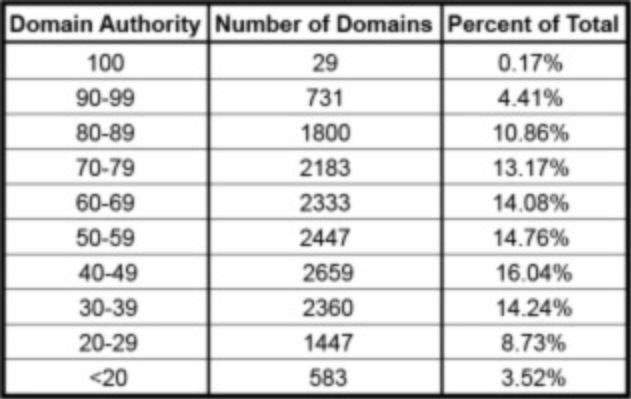
More than half the domains we saw being used by Google had a Domain Authority of 60 or less. If you are not familiar with Domain Authority (DA), it’s an attempt by Moz to measure the overall authority of a site as measured by links in a manner similar to how Google does it, and higher DA sites are considered more authoritative.
For example, Wikipedia has a DA of 100, the highest possible score. Sites with a DA of 60 or less are far more common, but arguably 10,000 times less than authoritative as Wikipedia. As you can see in the above table, we found sites with Featured Snippets that had scores of less than 40, 30, and even 20. In other words, sites with little overall authority were able to get them.
In addition, a large percentage of the sites that we saw with Featured Snippets weren’t in the number one spot on the regular web search results. For example, here is one example from SteadyDemand.com, where it gets a Featured Snippet in spite of the fact that it ranks number three in the regular search results:
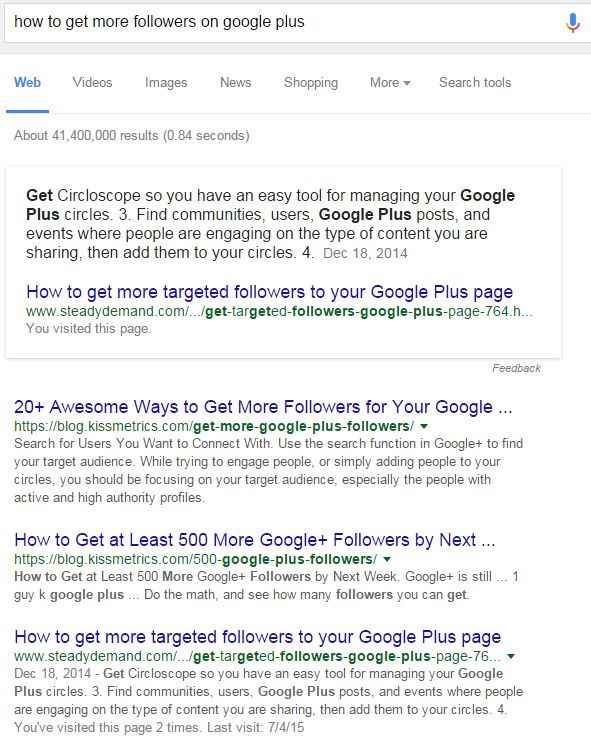
Prior to obtaining the Featured Snippet, Steady Demand was already in the number three spot in the results. Steady Demand did nothing to add to the link authority of the page, or the site, but started getting the Featured Snippet based on the nature of the content found on the page. The result continues to rank number three in the SERPs, but the Featured Snippet is displayed above the number one search result. Sweet!
How Can I Get a Featured Snippet for My Site?
Now that we’ve established that you can get a Featured Snippet, and that it doesn’t appear to be authority-dependent, let’s examine what it does require. To study this, we conducted another test. Here is what we did:
- We made a list of five common questions about SEO.
- We shot five videos, one for each topic.
- Each video answered one of the questions, but also covered substantially more related info on the topic.
- We created transcripts for each video.
- We created pages that included the video and the transcript, and made sure that the direct answer to the question was easily found by users (and search engines) on the page.
- We published each of the pages with the transcripts and the video on our site (stonetemple.com).
- We made sure that Google discovered these pages quickly, by sharing them in Google+, and by using the URL Submit tool in Search Console.
After three days, two of the pages started to show a Featured Snippet. That’s a 40 percent success rate. I’ll take it!
Here is an example from our experiment in action, using the phrase how to implement a nofollow:
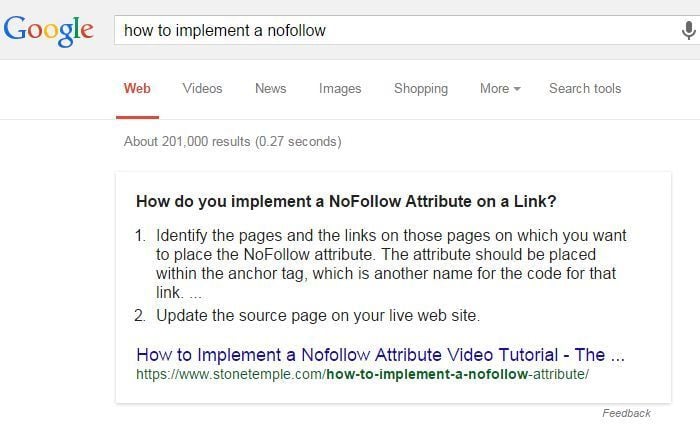
It’s important to note that there is no need to create a video. We chose to do that because we wanted to have the videos anyway, but the data in our testing showed no dependence on video content to get a Featured Snippet. In addition, we didn’t use any Schema markup. Our study showed no indication that this either helped or hurt with getting a Featured Snippet. It does appear, though, that all the pages we saw getting Featured Snippets were in the top 10 of Google’s results.
So how can it be this easy? If you look to the core of it, Google is trying to provide better experiences for users in their search results. They believe that these Featured Snippets are a big part of that, and they are hungry (starved, even) to obtain more and more information and data to provide to users.
Sites that make it easy for users to get answers to questions are seen by Google as valuable to users, and it also makes it easier for them to get the information that Google so craves. This is an easy win-win for Google: better user experiences on websites and better results for Google in the SERPs.
In summary, following the process I outlined above will increase your chances of obtaining a Featured Snippet. If you are currently in the top 10 on a given page, and you are struggling to move up, consider making content modifications, and take a shot at changing the rules of the game. Take a shot at rocketing to the top. It just might work for you!
Get more content like this, plus the very BEST marketing education, totally free. Get our Definitive email newsletter.

